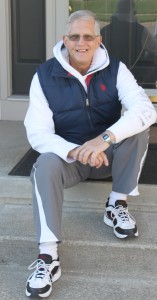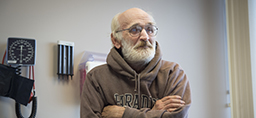
Chuck Lesiewicz knows all about pumping iron. He used to lift 305 pounds every time he worked out.
These days, cardiothoracic and vascular specialists at Spectrum Health are helping lift a weight off his shoulders.
Chuck, 62, has multiple aneurysms in his heart, discovered after one in the upper portion of his aorta dissected and bled in 2009.
He knows that without proper ongoing care from Spectrum Health specialist teams, he could be a walking time bomb.
He’s grateful for the professional help. Grateful for a second chance. Grateful to be alive.
Six years ago, when he was celebrating his 31st wedding anniversary at a Manistee casino, slot machines had swallowed his allotted gambling allowance.
He sat down on a chair to watch his wife, Paulette, continue to try her luck.
It was around 10 p.m.
“She said, ‘Hey, you want to get something to eat before we go up to the room?’” Chuck recalled. “I got out of my chair and that was it. I felt like I got stuck with a harpoon.”
Paulette thought maybe the chili dogs they had eaten for lunch were causing heart burn.
“After I hit the floor, I knew this wasn’t no heart burn,” Chuck said. “I was laying on the floor. I thought the end of my life was right there.”
Amid the sound of clanging and jingling slot machines came the sound of sirens.
The retired General Motors employee was transported to a nearby hospital where he spent the next five hours waiting for a diagnosis.
“I could barely breathe,” he said. “I had to take really small breaths. They got me on some pure oxygen. The morning doctor re-read the scan and said I had an aneurysm.”
AeroMed air medical transport had already been dispatched on a call, so Chuck was loaded into an ambulance for the two-hour trip to Spectrum Health Butterworth Hospital.
Cardiothoracic surgeon Edward Murphy, MD, met him when he arrived.
“I’ll never forget this moment,” Chuck said. “When they brought me out of the back of the ambulance, Dr. Murphy was there with his team.”
Chuck’s daughter, Veronica Sanders, arrived as Chuck was about to be whisked off to surgery.
About half of patients with the same condition die before they reach the hospital.
“He was far away and he needed emergency surgery,” Dr. Murphy said. “We were able to be ready for him for a surgery that isn’t offered everywhere. He had a life-threatening problem and we were able to take care of the immediate problem.”
Dr. Murphy credits the entire surgical team for Chuck’s positive outcome.
“It’s not just me as a surgeon, it’s the anesthesiologists, the recovery team, the ICU nurses, it’s everyone involved,” Dr. Murphy said.
During the nine-hour procedure, Dr. Murphy and his team repaired the aneurysm in the upper portion of Chuck’s aorta.
“Your artery is like a tire on a car,” Chuck explained. “There’s a tube and there’s a tire. The inner tube tore and blood got in behind those walls. That’s where all the pain came from. Your heart is just pumping blood. It doesn’t care where it’s going.”
During the surgery, the surgical team discovered four more aneurysms.
A year later, vascular surgeon Christopher Chambers, MD, PhD, operated on the lower portion of Chuck’s aorta.
The remaining aneurysms are being monitored closely by Dr. Murphy, Dr. Chambers, cardiologist Ryan Madder, MD, and nurse practitioner Edie Paul.
“These patients have to be followed for life after they have this problem,” Dr. Murphy explained. “We keep tabs on the size of them. It requires an entire team–heart surgical care, cardiac care and vascular surgical care. He’s gotten it all and he continues to get it all here.”
Initially, Chuck needed scans every 90 days. He now visits once a year because the remaining aneurysms have not grown.
“He’s doing great,” Dr. Murphy said. “He takes very good care of himself and he’s evidence that a patient who is diligent about taking care of himself and seeing his doctors can have a serious problem like this and still do very well long term.”
Chuck’s prognosis is positive, although he may need additional surgeries in the future.
Dr. Murphy has coached him on symptoms that would necessitate immediate medical attention, such as severe back pain.
“It’s very rare to have that many,” Chuck said. “It’s very rare that anybody survives. It was because of the physical condition I was in that I survived. I was in above excellent shape for a guy my age.”
Chuck’s desire to stay in shape hasn’t subsided. He bought a commercial elliptical machine after he recovered from surgery and works out five times a week.
“I have to if I want to live,” he said. “Even though they haven’t grown in size, they could go off at any time, just like the other one did.”
Chuck said he has learned to take life day-by-day. No looking ahead too far. Life is a series of moments, and those moments are cherished.
His next cherished moment—warm weather.
He will unplug his elliptical machine and hit the bike trails.
“I’m two blocks from the trail,” the Walker resident said. “I can hop on and go anywhere. I’m trying to do everything right. I have to. I want to live. I want to see my grandkids grow up.”

 /a>
/a>
 /a>
/a>
 /a>
/a>
Chuck, shame on me. I never even KNEW about this until I just read this. I know we, as a family, have not kept up with all of us, and I’m so glad to be in touch with many of my cousins, and Aunt Cookie again. Bless you and Prayers will be sent your way and will continue to. Love, you cuz Judi Todd (Aunt Lottie’s oldest).
Sorry to hear about your health. You and your family will be in my thoughts and every prayer. God be with you